Introduction to Research in Contemporary Business: Herzberg's Theory
VerifiedAdded on 2021/02/21
|13
|3690
|92
Report
AI Summary
This report delves into contemporary business issues, focusing on Herzberg's Motivation Theory to understand the psychological phenomenon of employee satisfaction. It describes the theory, its propositions, and provides examples from research in Ghana, Turkey, and the Republic of Macedonia. The report identifies a research topic concerning Herzberg's theory's contribution to psychology and employee satisfaction, along with two research questions. It then explains and compares various research methodologies, including research philosophy (pragmatism, positivism, realism, and interpretivism) and research approaches (deductive and inductive), justifying the use of interpretivism for gathering understandable information. The report highlights the importance of both motivational and hygiene factors, with a particular emphasis on the role of salary in employee satisfaction. The analysis includes a critical review of the application and limitations of Herzberg's theory in different organizational contexts.
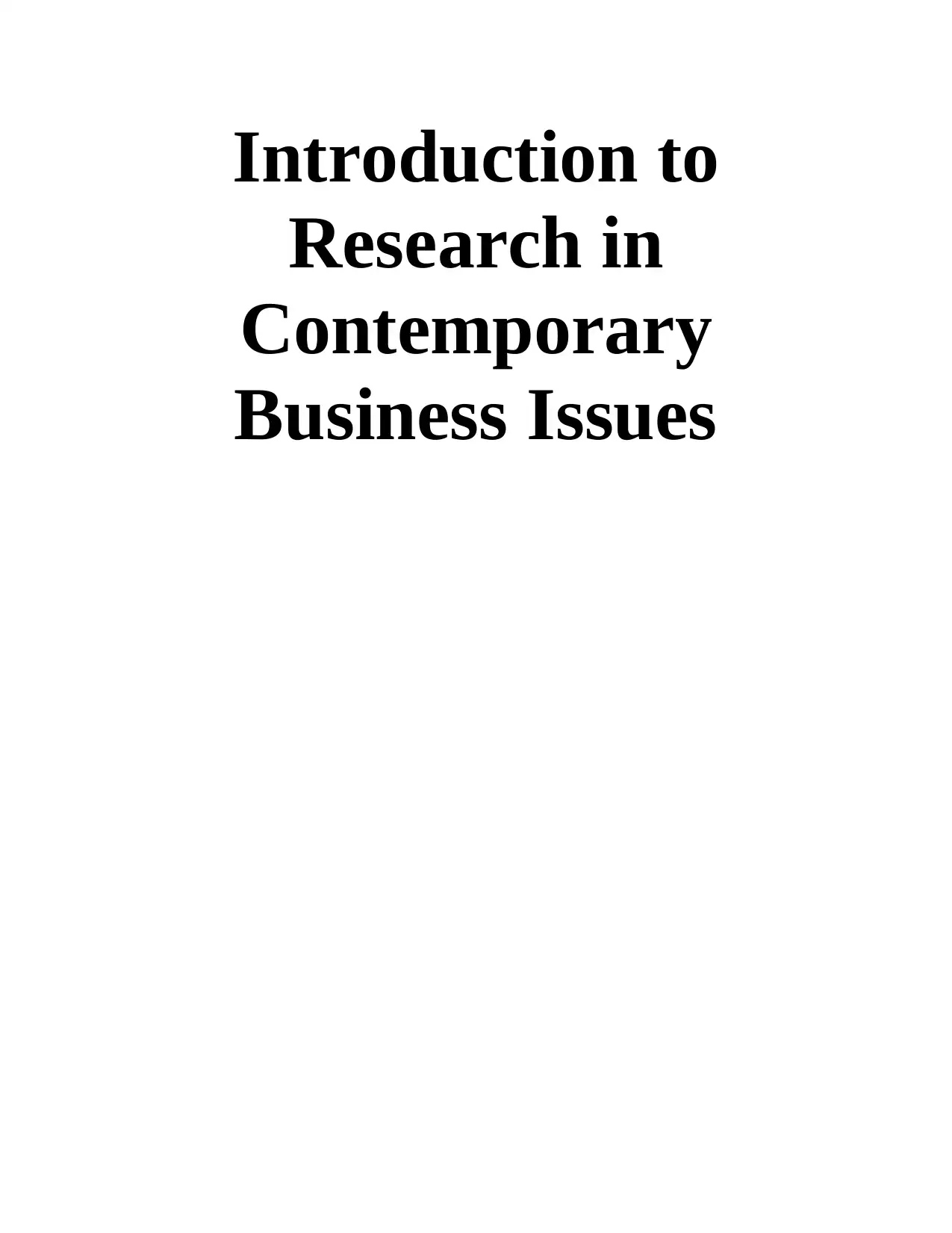
Introduction to
Research in
Contemporary
Business Issues
Research in
Contemporary
Business Issues
Paraphrase This Document
Need a fresh take? Get an instant paraphrase of this document with our AI Paraphraser
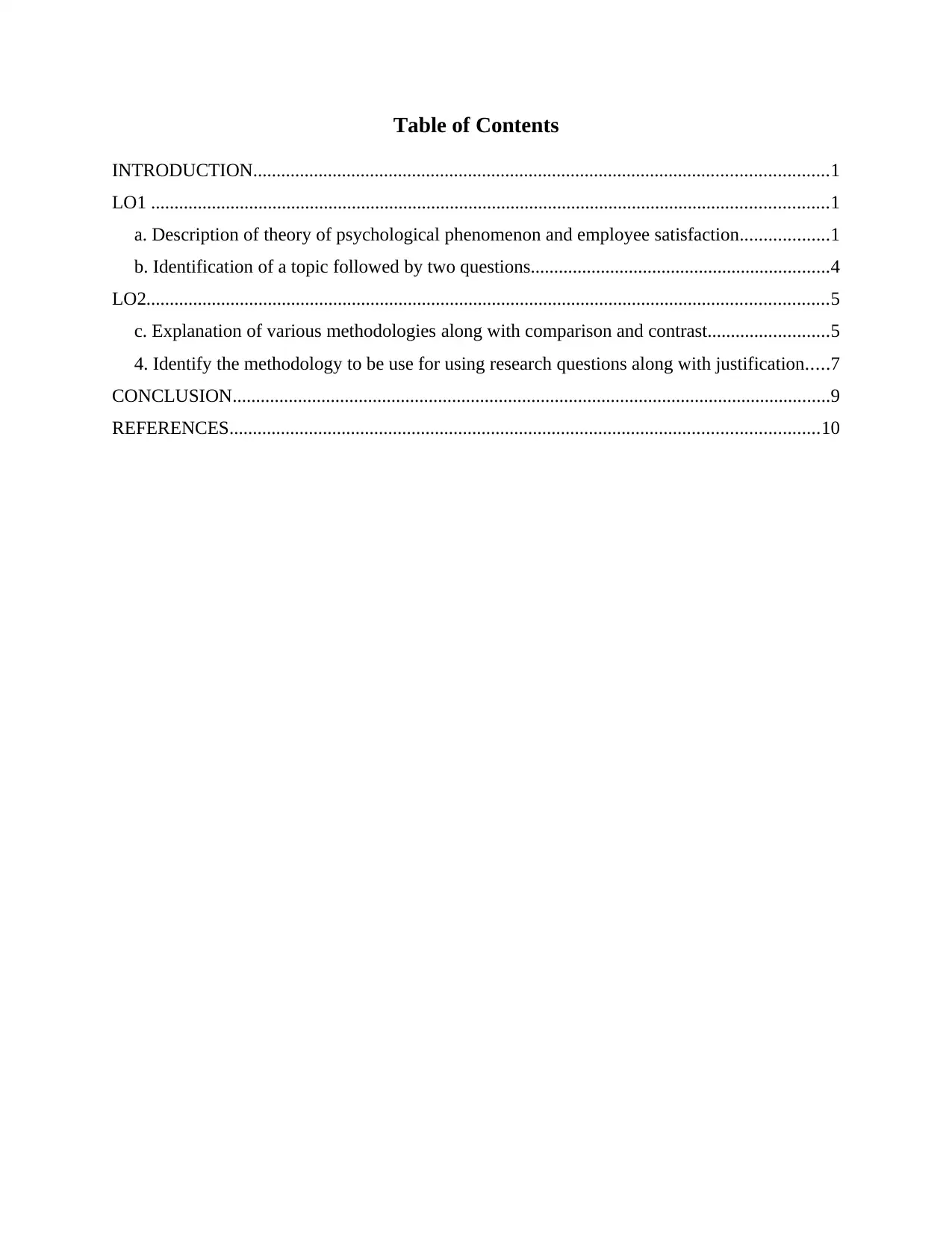
Table of Contents
INTRODUCTION...........................................................................................................................1
LO1 .................................................................................................................................................1
a. Description of theory of psychological phenomenon and employee satisfaction...................1
b. Identification of a topic followed by two questions................................................................4
LO2..................................................................................................................................................5
c. Explanation of various methodologies along with comparison and contrast..........................5
4. Identify the methodology to be use for using research questions along with justification.....7
CONCLUSION................................................................................................................................9
REFERENCES..............................................................................................................................10
INTRODUCTION...........................................................................................................................1
LO1 .................................................................................................................................................1
a. Description of theory of psychological phenomenon and employee satisfaction...................1
b. Identification of a topic followed by two questions................................................................4
LO2..................................................................................................................................................5
c. Explanation of various methodologies along with comparison and contrast..........................5
4. Identify the methodology to be use for using research questions along with justification.....7
CONCLUSION................................................................................................................................9
REFERENCES..............................................................................................................................10
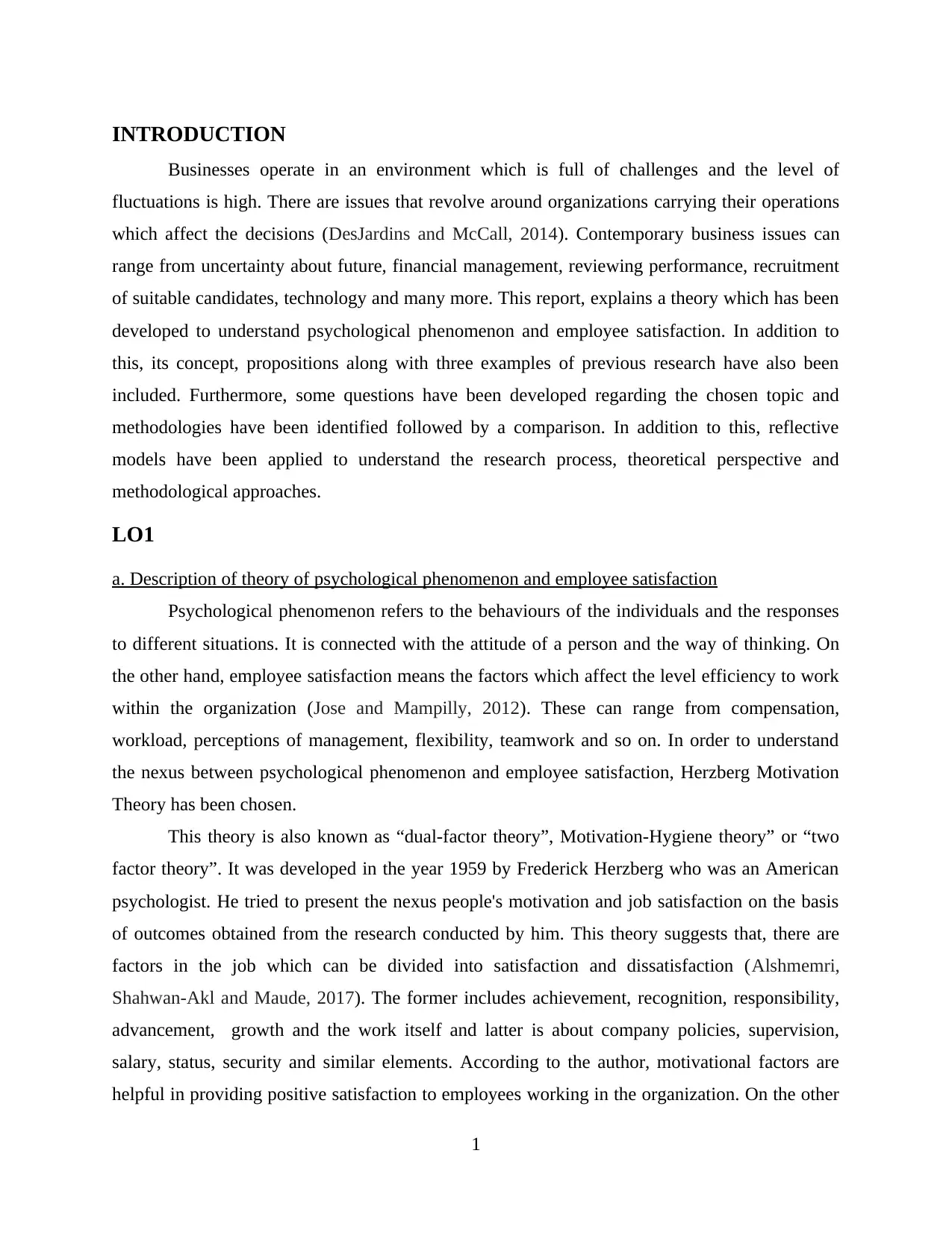
INTRODUCTION
Businesses operate in an environment which is full of challenges and the level of
fluctuations is high. There are issues that revolve around organizations carrying their operations
which affect the decisions (DesJardins and McCall, 2014). Contemporary business issues can
range from uncertainty about future, financial management, reviewing performance, recruitment
of suitable candidates, technology and many more. This report, explains a theory which has been
developed to understand psychological phenomenon and employee satisfaction. In addition to
this, its concept, propositions along with three examples of previous research have also been
included. Furthermore, some questions have been developed regarding the chosen topic and
methodologies have been identified followed by a comparison. In addition to this, reflective
models have been applied to understand the research process, theoretical perspective and
methodological approaches.
LO1
a. Description of theory of psychological phenomenon and employee satisfaction
Psychological phenomenon refers to the behaviours of the individuals and the responses
to different situations. It is connected with the attitude of a person and the way of thinking. On
the other hand, employee satisfaction means the factors which affect the level efficiency to work
within the organization (Jose and Mampilly, 2012). These can range from compensation,
workload, perceptions of management, flexibility, teamwork and so on. In order to understand
the nexus between psychological phenomenon and employee satisfaction, Herzberg Motivation
Theory has been chosen.
This theory is also known as “dual-factor theory”, Motivation-Hygiene theory” or “two
factor theory”. It was developed in the year 1959 by Frederick Herzberg who was an American
psychologist. He tried to present the nexus people's motivation and job satisfaction on the basis
of outcomes obtained from the research conducted by him. This theory suggests that, there are
factors in the job which can be divided into satisfaction and dissatisfaction (Alshmemri,
Shahwan-Akl and Maude, 2017). The former includes achievement, recognition, responsibility,
advancement, growth and the work itself and latter is about company policies, supervision,
salary, status, security and similar elements. According to the author, motivational factors are
helpful in providing positive satisfaction to employees working in the organization. On the other
1
Businesses operate in an environment which is full of challenges and the level of
fluctuations is high. There are issues that revolve around organizations carrying their operations
which affect the decisions (DesJardins and McCall, 2014). Contemporary business issues can
range from uncertainty about future, financial management, reviewing performance, recruitment
of suitable candidates, technology and many more. This report, explains a theory which has been
developed to understand psychological phenomenon and employee satisfaction. In addition to
this, its concept, propositions along with three examples of previous research have also been
included. Furthermore, some questions have been developed regarding the chosen topic and
methodologies have been identified followed by a comparison. In addition to this, reflective
models have been applied to understand the research process, theoretical perspective and
methodological approaches.
LO1
a. Description of theory of psychological phenomenon and employee satisfaction
Psychological phenomenon refers to the behaviours of the individuals and the responses
to different situations. It is connected with the attitude of a person and the way of thinking. On
the other hand, employee satisfaction means the factors which affect the level efficiency to work
within the organization (Jose and Mampilly, 2012). These can range from compensation,
workload, perceptions of management, flexibility, teamwork and so on. In order to understand
the nexus between psychological phenomenon and employee satisfaction, Herzberg Motivation
Theory has been chosen.
This theory is also known as “dual-factor theory”, Motivation-Hygiene theory” or “two
factor theory”. It was developed in the year 1959 by Frederick Herzberg who was an American
psychologist. He tried to present the nexus people's motivation and job satisfaction on the basis
of outcomes obtained from the research conducted by him. This theory suggests that, there are
factors in the job which can be divided into satisfaction and dissatisfaction (Alshmemri,
Shahwan-Akl and Maude, 2017). The former includes achievement, recognition, responsibility,
advancement, growth and the work itself and latter is about company policies, supervision,
salary, status, security and similar elements. According to the author, motivational factors are
helpful in providing positive satisfaction to employees working in the organization. On the other
1
⊘ This is a preview!⊘
Do you want full access?
Subscribe today to unlock all pages.

Trusted by 1+ million students worldwide
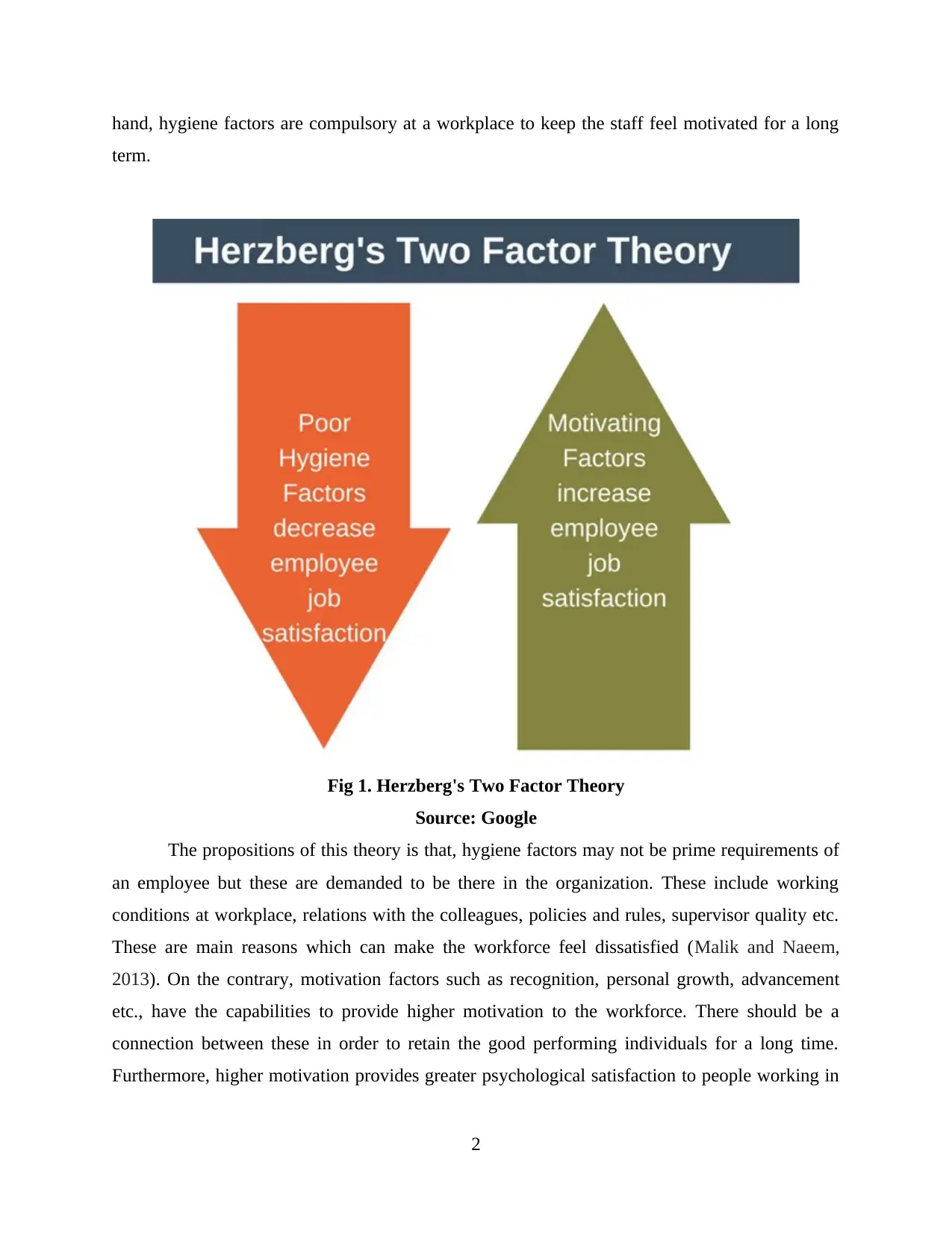
hand, hygiene factors are compulsory at a workplace to keep the staff feel motivated for a long
term.
Fig 1. Herzberg's Two Factor Theory
Source: Google
The propositions of this theory is that, hygiene factors may not be prime requirements of
an employee but these are demanded to be there in the organization. These include working
conditions at workplace, relations with the colleagues, policies and rules, supervisor quality etc.
These are main reasons which can make the workforce feel dissatisfied (Malik and Naeem,
2013). On the contrary, motivation factors such as recognition, personal growth, advancement
etc., have the capabilities to provide higher motivation to the workforce. There should be a
connection between these in order to retain the good performing individuals for a long time.
Furthermore, higher motivation provides greater psychological satisfaction to people working in
2
term.
Fig 1. Herzberg's Two Factor Theory
Source: Google
The propositions of this theory is that, hygiene factors may not be prime requirements of
an employee but these are demanded to be there in the organization. These include working
conditions at workplace, relations with the colleagues, policies and rules, supervisor quality etc.
These are main reasons which can make the workforce feel dissatisfied (Malik and Naeem,
2013). On the contrary, motivation factors such as recognition, personal growth, advancement
etc., have the capabilities to provide higher motivation to the workforce. There should be a
connection between these in order to retain the good performing individuals for a long time.
Furthermore, higher motivation provides greater psychological satisfaction to people working in
2
Paraphrase This Document
Need a fresh take? Get an instant paraphrase of this document with our AI Paraphraser
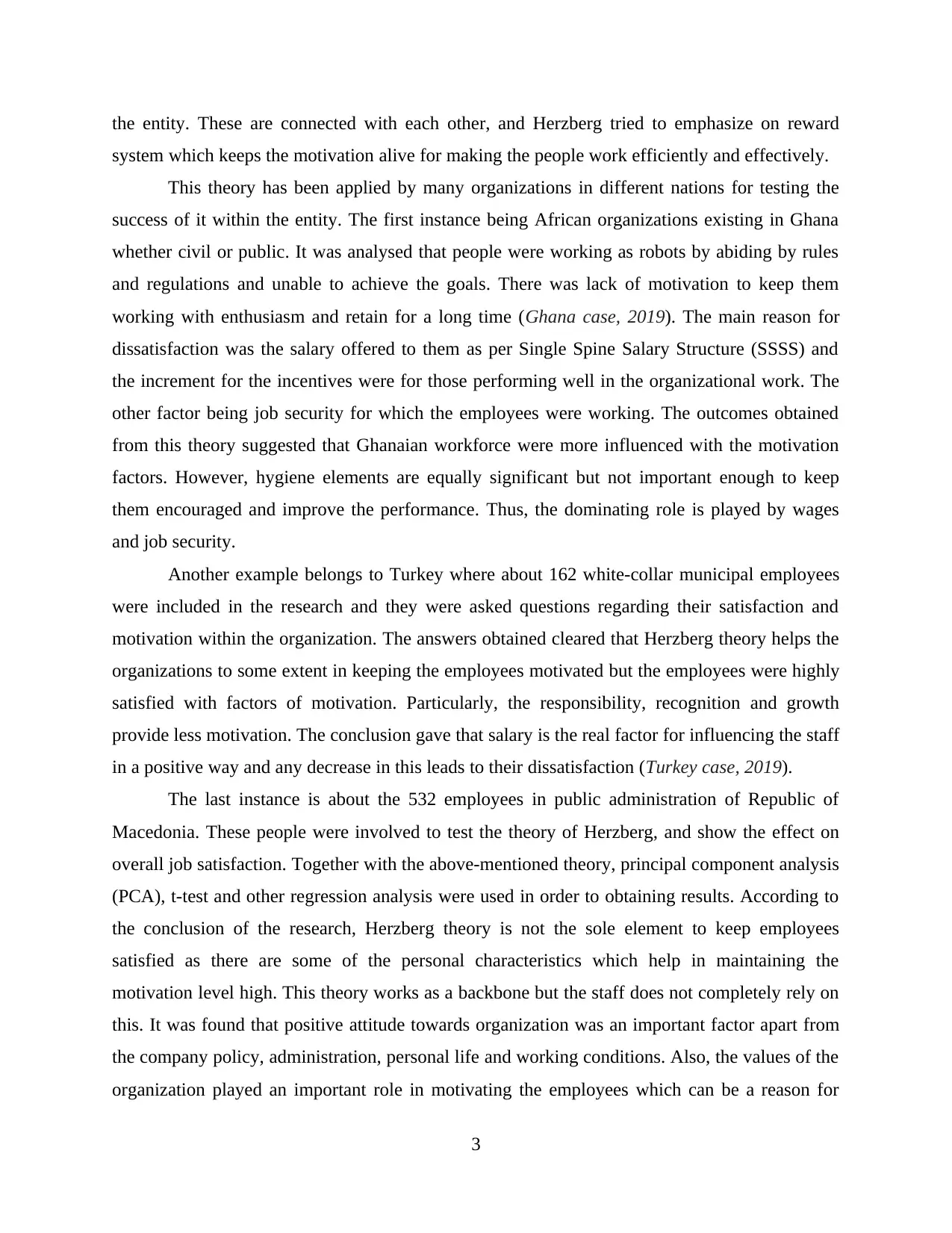
the entity. These are connected with each other, and Herzberg tried to emphasize on reward
system which keeps the motivation alive for making the people work efficiently and effectively.
This theory has been applied by many organizations in different nations for testing the
success of it within the entity. The first instance being African organizations existing in Ghana
whether civil or public. It was analysed that people were working as robots by abiding by rules
and regulations and unable to achieve the goals. There was lack of motivation to keep them
working with enthusiasm and retain for a long time (Ghana case, 2019). The main reason for
dissatisfaction was the salary offered to them as per Single Spine Salary Structure (SSSS) and
the increment for the incentives were for those performing well in the organizational work. The
other factor being job security for which the employees were working. The outcomes obtained
from this theory suggested that Ghanaian workforce were more influenced with the motivation
factors. However, hygiene elements are equally significant but not important enough to keep
them encouraged and improve the performance. Thus, the dominating role is played by wages
and job security.
Another example belongs to Turkey where about 162 white-collar municipal employees
were included in the research and they were asked questions regarding their satisfaction and
motivation within the organization. The answers obtained cleared that Herzberg theory helps the
organizations to some extent in keeping the employees motivated but the employees were highly
satisfied with factors of motivation. Particularly, the responsibility, recognition and growth
provide less motivation. The conclusion gave that salary is the real factor for influencing the staff
in a positive way and any decrease in this leads to their dissatisfaction (Turkey case, 2019).
The last instance is about the 532 employees in public administration of Republic of
Macedonia. These people were involved to test the theory of Herzberg, and show the effect on
overall job satisfaction. Together with the above-mentioned theory, principal component analysis
(PCA), t-test and other regression analysis were used in order to obtaining results. According to
the conclusion of the research, Herzberg theory is not the sole element to keep employees
satisfied as there are some of the personal characteristics which help in maintaining the
motivation level high. This theory works as a backbone but the staff does not completely rely on
this. It was found that positive attitude towards organization was an important factor apart from
the company policy, administration, personal life and working conditions. Also, the values of the
organization played an important role in motivating the employees which can be a reason for
3
system which keeps the motivation alive for making the people work efficiently and effectively.
This theory has been applied by many organizations in different nations for testing the
success of it within the entity. The first instance being African organizations existing in Ghana
whether civil or public. It was analysed that people were working as robots by abiding by rules
and regulations and unable to achieve the goals. There was lack of motivation to keep them
working with enthusiasm and retain for a long time (Ghana case, 2019). The main reason for
dissatisfaction was the salary offered to them as per Single Spine Salary Structure (SSSS) and
the increment for the incentives were for those performing well in the organizational work. The
other factor being job security for which the employees were working. The outcomes obtained
from this theory suggested that Ghanaian workforce were more influenced with the motivation
factors. However, hygiene elements are equally significant but not important enough to keep
them encouraged and improve the performance. Thus, the dominating role is played by wages
and job security.
Another example belongs to Turkey where about 162 white-collar municipal employees
were included in the research and they were asked questions regarding their satisfaction and
motivation within the organization. The answers obtained cleared that Herzberg theory helps the
organizations to some extent in keeping the employees motivated but the employees were highly
satisfied with factors of motivation. Particularly, the responsibility, recognition and growth
provide less motivation. The conclusion gave that salary is the real factor for influencing the staff
in a positive way and any decrease in this leads to their dissatisfaction (Turkey case, 2019).
The last instance is about the 532 employees in public administration of Republic of
Macedonia. These people were involved to test the theory of Herzberg, and show the effect on
overall job satisfaction. Together with the above-mentioned theory, principal component analysis
(PCA), t-test and other regression analysis were used in order to obtaining results. According to
the conclusion of the research, Herzberg theory is not the sole element to keep employees
satisfied as there are some of the personal characteristics which help in maintaining the
motivation level high. This theory works as a backbone but the staff does not completely rely on
this. It was found that positive attitude towards organization was an important factor apart from
the company policy, administration, personal life and working conditions. Also, the values of the
organization played an important role in motivating the employees which can be a reason for
3
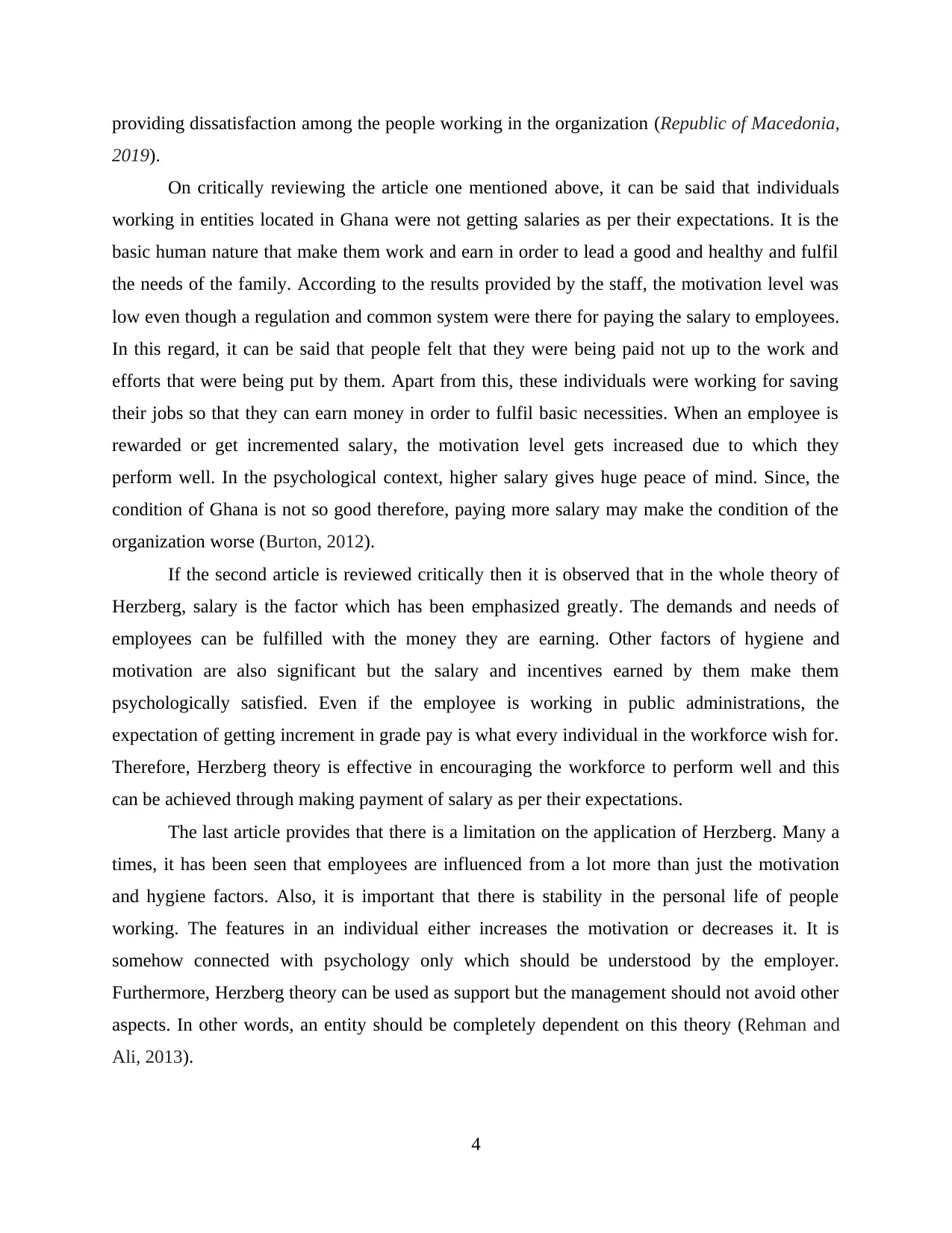
providing dissatisfaction among the people working in the organization (Republic of Macedonia,
2019).
On critically reviewing the article one mentioned above, it can be said that individuals
working in entities located in Ghana were not getting salaries as per their expectations. It is the
basic human nature that make them work and earn in order to lead a good and healthy and fulfil
the needs of the family. According to the results provided by the staff, the motivation level was
low even though a regulation and common system were there for paying the salary to employees.
In this regard, it can be said that people felt that they were being paid not up to the work and
efforts that were being put by them. Apart from this, these individuals were working for saving
their jobs so that they can earn money in order to fulfil basic necessities. When an employee is
rewarded or get incremented salary, the motivation level gets increased due to which they
perform well. In the psychological context, higher salary gives huge peace of mind. Since, the
condition of Ghana is not so good therefore, paying more salary may make the condition of the
organization worse (Burton, 2012).
If the second article is reviewed critically then it is observed that in the whole theory of
Herzberg, salary is the factor which has been emphasized greatly. The demands and needs of
employees can be fulfilled with the money they are earning. Other factors of hygiene and
motivation are also significant but the salary and incentives earned by them make them
psychologically satisfied. Even if the employee is working in public administrations, the
expectation of getting increment in grade pay is what every individual in the workforce wish for.
Therefore, Herzberg theory is effective in encouraging the workforce to perform well and this
can be achieved through making payment of salary as per their expectations.
The last article provides that there is a limitation on the application of Herzberg. Many a
times, it has been seen that employees are influenced from a lot more than just the motivation
and hygiene factors. Also, it is important that there is stability in the personal life of people
working. The features in an individual either increases the motivation or decreases it. It is
somehow connected with psychology only which should be understood by the employer.
Furthermore, Herzberg theory can be used as support but the management should not avoid other
aspects. In other words, an entity should be completely dependent on this theory (Rehman and
Ali, 2013).
4
2019).
On critically reviewing the article one mentioned above, it can be said that individuals
working in entities located in Ghana were not getting salaries as per their expectations. It is the
basic human nature that make them work and earn in order to lead a good and healthy and fulfil
the needs of the family. According to the results provided by the staff, the motivation level was
low even though a regulation and common system were there for paying the salary to employees.
In this regard, it can be said that people felt that they were being paid not up to the work and
efforts that were being put by them. Apart from this, these individuals were working for saving
their jobs so that they can earn money in order to fulfil basic necessities. When an employee is
rewarded or get incremented salary, the motivation level gets increased due to which they
perform well. In the psychological context, higher salary gives huge peace of mind. Since, the
condition of Ghana is not so good therefore, paying more salary may make the condition of the
organization worse (Burton, 2012).
If the second article is reviewed critically then it is observed that in the whole theory of
Herzberg, salary is the factor which has been emphasized greatly. The demands and needs of
employees can be fulfilled with the money they are earning. Other factors of hygiene and
motivation are also significant but the salary and incentives earned by them make them
psychologically satisfied. Even if the employee is working in public administrations, the
expectation of getting increment in grade pay is what every individual in the workforce wish for.
Therefore, Herzberg theory is effective in encouraging the workforce to perform well and this
can be achieved through making payment of salary as per their expectations.
The last article provides that there is a limitation on the application of Herzberg. Many a
times, it has been seen that employees are influenced from a lot more than just the motivation
and hygiene factors. Also, it is important that there is stability in the personal life of people
working. The features in an individual either increases the motivation or decreases it. It is
somehow connected with psychology only which should be understood by the employer.
Furthermore, Herzberg theory can be used as support but the management should not avoid other
aspects. In other words, an entity should be completely dependent on this theory (Rehman and
Ali, 2013).
4
⊘ This is a preview!⊘
Do you want full access?
Subscribe today to unlock all pages.

Trusted by 1+ million students worldwide
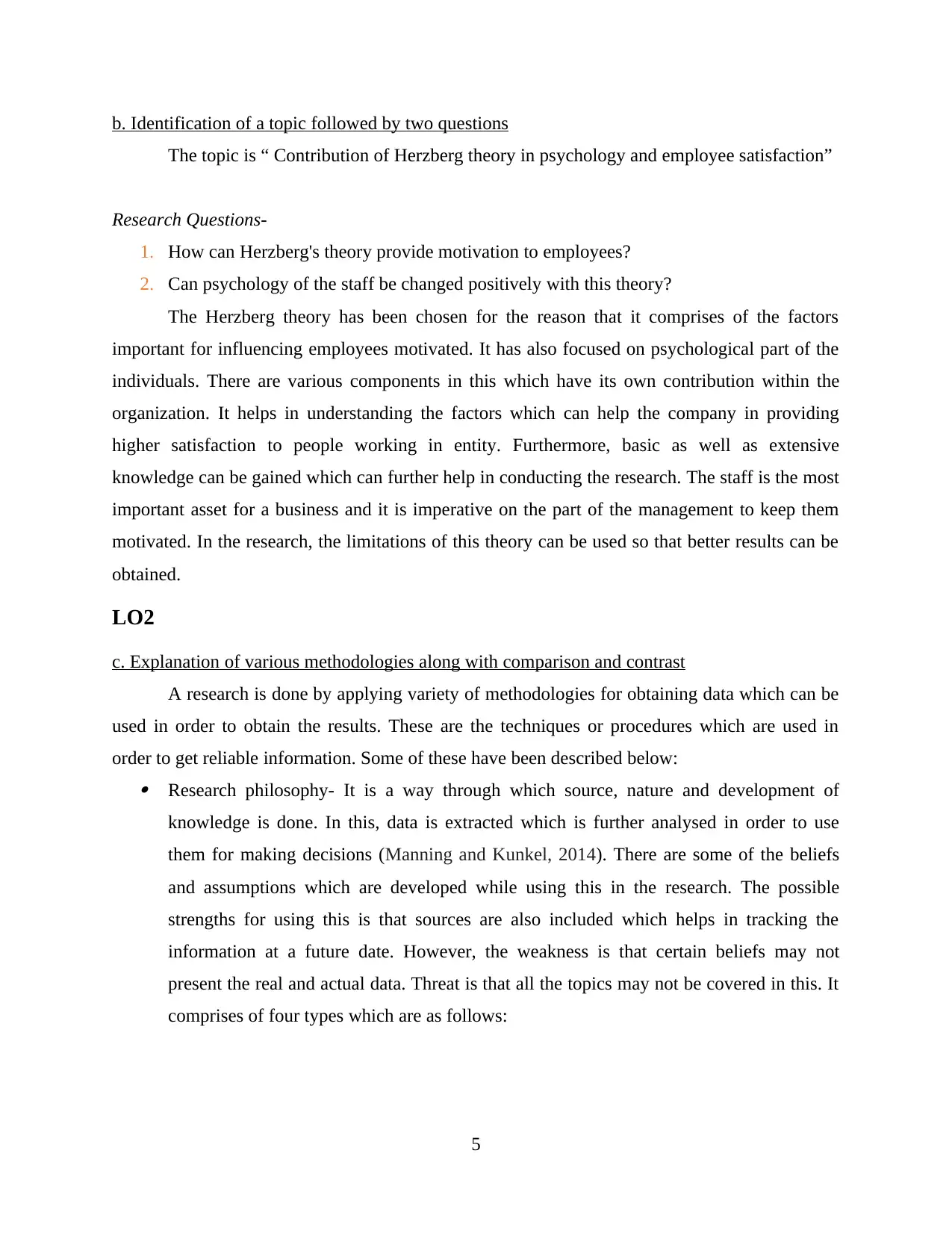
b. Identification of a topic followed by two questions
The topic is “ Contribution of Herzberg theory in psychology and employee satisfaction”
Research Questions-
1. How can Herzberg's theory provide motivation to employees?
2. Can psychology of the staff be changed positively with this theory?
The Herzberg theory has been chosen for the reason that it comprises of the factors
important for influencing employees motivated. It has also focused on psychological part of the
individuals. There are various components in this which have its own contribution within the
organization. It helps in understanding the factors which can help the company in providing
higher satisfaction to people working in entity. Furthermore, basic as well as extensive
knowledge can be gained which can further help in conducting the research. The staff is the most
important asset for a business and it is imperative on the part of the management to keep them
motivated. In the research, the limitations of this theory can be used so that better results can be
obtained.
LO2
c. Explanation of various methodologies along with comparison and contrast
A research is done by applying variety of methodologies for obtaining data which can be
used in order to obtain the results. These are the techniques or procedures which are used in
order to get reliable information. Some of these have been described below: Research philosophy- It is a way through which source, nature and development of
knowledge is done. In this, data is extracted which is further analysed in order to use
them for making decisions (Manning and Kunkel, 2014). There are some of the beliefs
and assumptions which are developed while using this in the research. The possible
strengths for using this is that sources are also included which helps in tracking the
information at a future date. However, the weakness is that certain beliefs may not
present the real and actual data. Threat is that all the topics may not be covered in this. It
comprises of four types which are as follows:
5
The topic is “ Contribution of Herzberg theory in psychology and employee satisfaction”
Research Questions-
1. How can Herzberg's theory provide motivation to employees?
2. Can psychology of the staff be changed positively with this theory?
The Herzberg theory has been chosen for the reason that it comprises of the factors
important for influencing employees motivated. It has also focused on psychological part of the
individuals. There are various components in this which have its own contribution within the
organization. It helps in understanding the factors which can help the company in providing
higher satisfaction to people working in entity. Furthermore, basic as well as extensive
knowledge can be gained which can further help in conducting the research. The staff is the most
important asset for a business and it is imperative on the part of the management to keep them
motivated. In the research, the limitations of this theory can be used so that better results can be
obtained.
LO2
c. Explanation of various methodologies along with comparison and contrast
A research is done by applying variety of methodologies for obtaining data which can be
used in order to obtain the results. These are the techniques or procedures which are used in
order to get reliable information. Some of these have been described below: Research philosophy- It is a way through which source, nature and development of
knowledge is done. In this, data is extracted which is further analysed in order to use
them for making decisions (Manning and Kunkel, 2014). There are some of the beliefs
and assumptions which are developed while using this in the research. The possible
strengths for using this is that sources are also included which helps in tracking the
information at a future date. However, the weakness is that certain beliefs may not
present the real and actual data. Threat is that all the topics may not be covered in this. It
comprises of four types which are as follows:
5
Paraphrase This Document
Need a fresh take? Get an instant paraphrase of this document with our AI Paraphraser
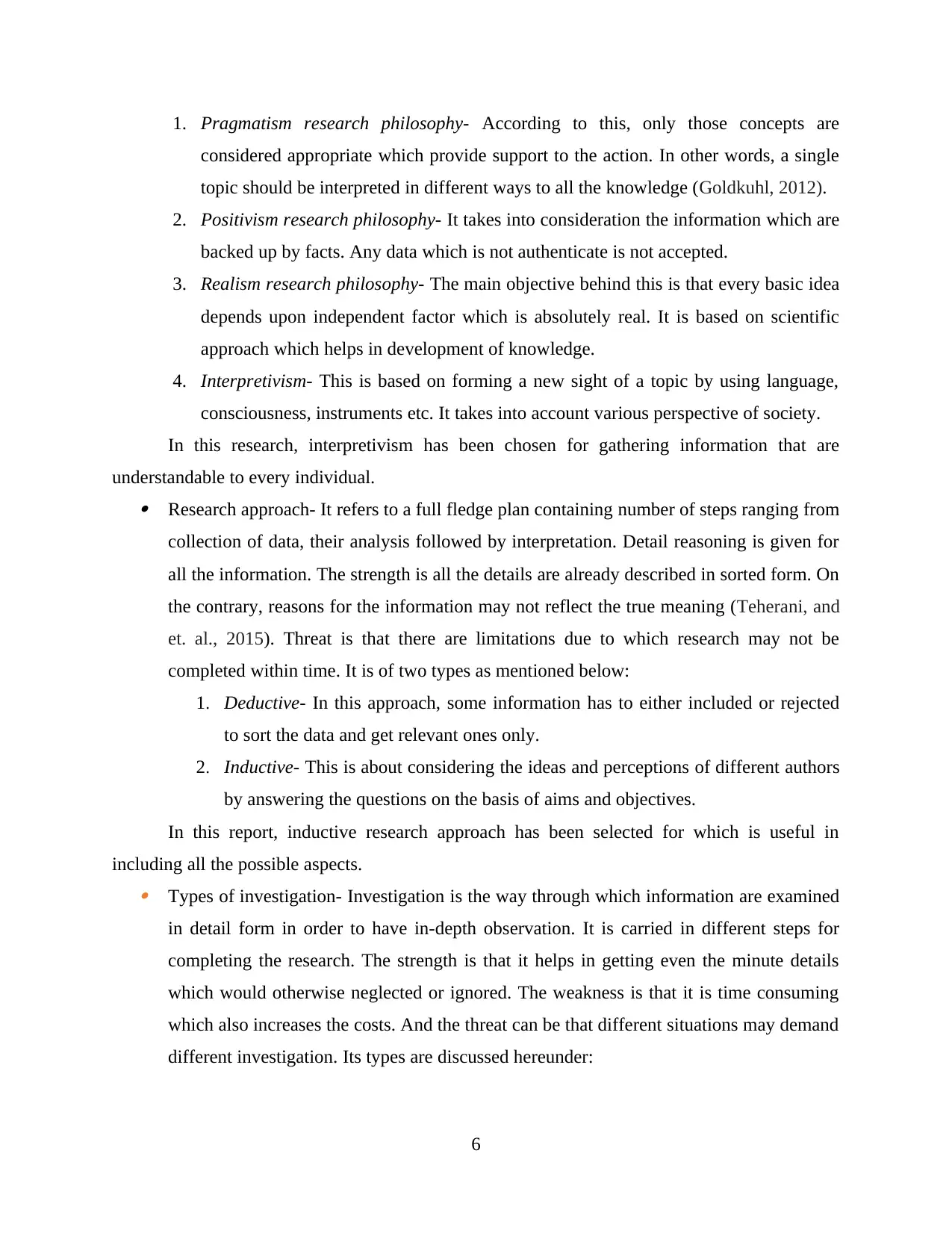
1. Pragmatism research philosophy- According to this, only those concepts are
considered appropriate which provide support to the action. In other words, a single
topic should be interpreted in different ways to all the knowledge (Goldkuhl, 2012).
2. Positivism research philosophy- It takes into consideration the information which are
backed up by facts. Any data which is not authenticate is not accepted.
3. Realism research philosophy- The main objective behind this is that every basic idea
depends upon independent factor which is absolutely real. It is based on scientific
approach which helps in development of knowledge.
4. Interpretivism- This is based on forming a new sight of a topic by using language,
consciousness, instruments etc. It takes into account various perspective of society.
In this research, interpretivism has been chosen for gathering information that are
understandable to every individual. Research approach- It refers to a full fledge plan containing number of steps ranging from
collection of data, their analysis followed by interpretation. Detail reasoning is given for
all the information. The strength is all the details are already described in sorted form. On
the contrary, reasons for the information may not reflect the true meaning (Teherani, and
et. al., 2015). Threat is that there are limitations due to which research may not be
completed within time. It is of two types as mentioned below:
1. Deductive- In this approach, some information has to either included or rejected
to sort the data and get relevant ones only.
2. Inductive- This is about considering the ideas and perceptions of different authors
by answering the questions on the basis of aims and objectives.
In this report, inductive research approach has been selected for which is useful in
including all the possible aspects. Types of investigation- Investigation is the way through which information are examined
in detail form in order to have in-depth observation. It is carried in different steps for
completing the research. The strength is that it helps in getting even the minute details
which would otherwise neglected or ignored. The weakness is that it is time consuming
which also increases the costs. And the threat can be that different situations may demand
different investigation. Its types are discussed hereunder:
6
considered appropriate which provide support to the action. In other words, a single
topic should be interpreted in different ways to all the knowledge (Goldkuhl, 2012).
2. Positivism research philosophy- It takes into consideration the information which are
backed up by facts. Any data which is not authenticate is not accepted.
3. Realism research philosophy- The main objective behind this is that every basic idea
depends upon independent factor which is absolutely real. It is based on scientific
approach which helps in development of knowledge.
4. Interpretivism- This is based on forming a new sight of a topic by using language,
consciousness, instruments etc. It takes into account various perspective of society.
In this research, interpretivism has been chosen for gathering information that are
understandable to every individual. Research approach- It refers to a full fledge plan containing number of steps ranging from
collection of data, their analysis followed by interpretation. Detail reasoning is given for
all the information. The strength is all the details are already described in sorted form. On
the contrary, reasons for the information may not reflect the true meaning (Teherani, and
et. al., 2015). Threat is that there are limitations due to which research may not be
completed within time. It is of two types as mentioned below:
1. Deductive- In this approach, some information has to either included or rejected
to sort the data and get relevant ones only.
2. Inductive- This is about considering the ideas and perceptions of different authors
by answering the questions on the basis of aims and objectives.
In this report, inductive research approach has been selected for which is useful in
including all the possible aspects. Types of investigation- Investigation is the way through which information are examined
in detail form in order to have in-depth observation. It is carried in different steps for
completing the research. The strength is that it helps in getting even the minute details
which would otherwise neglected or ignored. The weakness is that it is time consuming
which also increases the costs. And the threat can be that different situations may demand
different investigation. Its types are discussed hereunder:
6
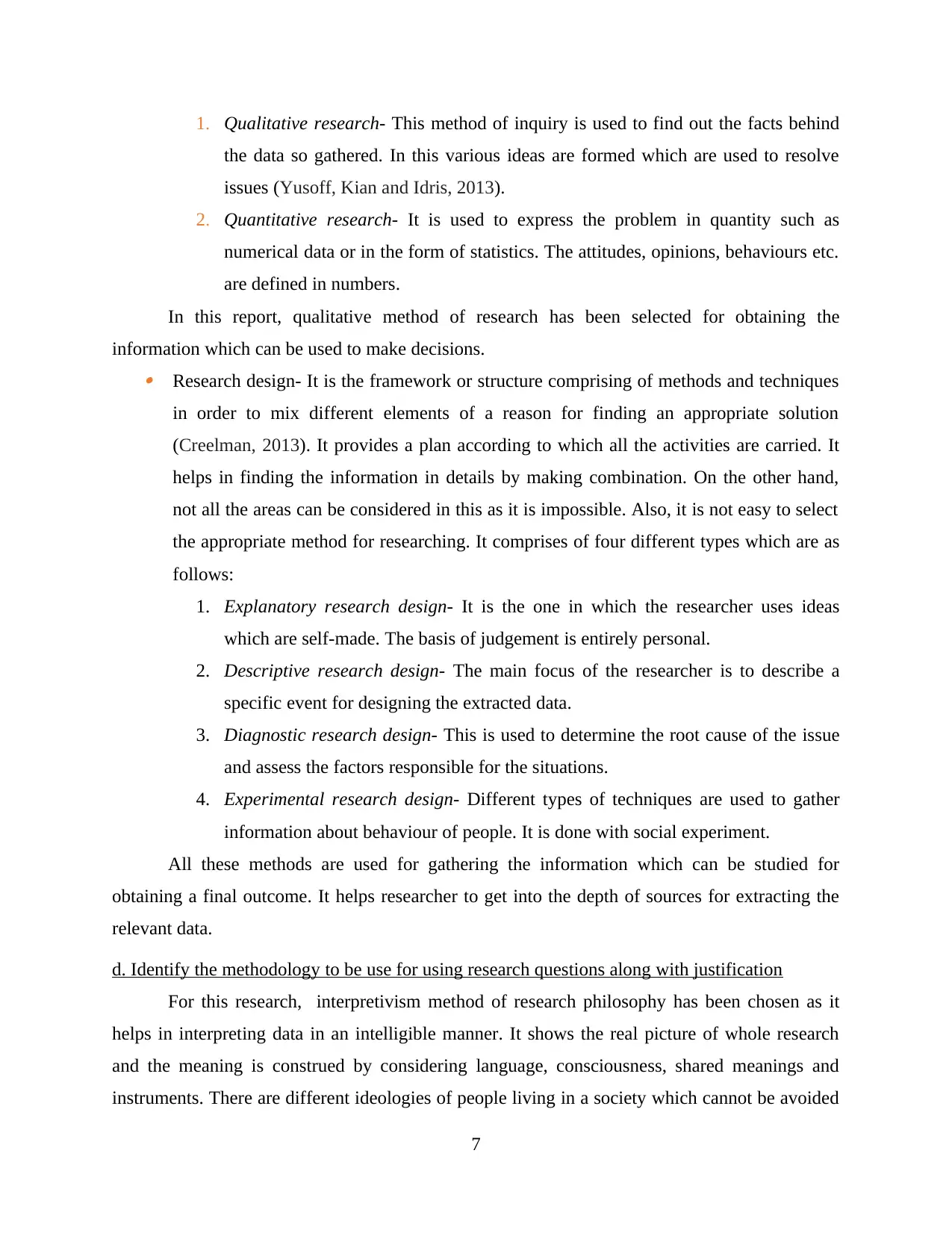
1. Qualitative research- This method of inquiry is used to find out the facts behind
the data so gathered. In this various ideas are formed which are used to resolve
issues (Yusoff, Kian and Idris, 2013).
2. Quantitative research- It is used to express the problem in quantity such as
numerical data or in the form of statistics. The attitudes, opinions, behaviours etc.
are defined in numbers.
In this report, qualitative method of research has been selected for obtaining the
information which can be used to make decisions. Research design- It is the framework or structure comprising of methods and techniques
in order to mix different elements of a reason for finding an appropriate solution
(Creelman, 2013). It provides a plan according to which all the activities are carried. It
helps in finding the information in details by making combination. On the other hand,
not all the areas can be considered in this as it is impossible. Also, it is not easy to select
the appropriate method for researching. It comprises of four different types which are as
follows:
1. Explanatory research design- It is the one in which the researcher uses ideas
which are self-made. The basis of judgement is entirely personal.
2. Descriptive research design- The main focus of the researcher is to describe a
specific event for designing the extracted data.
3. Diagnostic research design- This is used to determine the root cause of the issue
and assess the factors responsible for the situations.
4. Experimental research design- Different types of techniques are used to gather
information about behaviour of people. It is done with social experiment.
All these methods are used for gathering the information which can be studied for
obtaining a final outcome. It helps researcher to get into the depth of sources for extracting the
relevant data.
d. Identify the methodology to be use for using research questions along with justification
For this research, interpretivism method of research philosophy has been chosen as it
helps in interpreting data in an intelligible manner. It shows the real picture of whole research
and the meaning is construed by considering language, consciousness, shared meanings and
instruments. There are different ideologies of people living in a society which cannot be avoided
7
the data so gathered. In this various ideas are formed which are used to resolve
issues (Yusoff, Kian and Idris, 2013).
2. Quantitative research- It is used to express the problem in quantity such as
numerical data or in the form of statistics. The attitudes, opinions, behaviours etc.
are defined in numbers.
In this report, qualitative method of research has been selected for obtaining the
information which can be used to make decisions. Research design- It is the framework or structure comprising of methods and techniques
in order to mix different elements of a reason for finding an appropriate solution
(Creelman, 2013). It provides a plan according to which all the activities are carried. It
helps in finding the information in details by making combination. On the other hand,
not all the areas can be considered in this as it is impossible. Also, it is not easy to select
the appropriate method for researching. It comprises of four different types which are as
follows:
1. Explanatory research design- It is the one in which the researcher uses ideas
which are self-made. The basis of judgement is entirely personal.
2. Descriptive research design- The main focus of the researcher is to describe a
specific event for designing the extracted data.
3. Diagnostic research design- This is used to determine the root cause of the issue
and assess the factors responsible for the situations.
4. Experimental research design- Different types of techniques are used to gather
information about behaviour of people. It is done with social experiment.
All these methods are used for gathering the information which can be studied for
obtaining a final outcome. It helps researcher to get into the depth of sources for extracting the
relevant data.
d. Identify the methodology to be use for using research questions along with justification
For this research, interpretivism method of research philosophy has been chosen as it
helps in interpreting data in an intelligible manner. It shows the real picture of whole research
and the meaning is construed by considering language, consciousness, shared meanings and
instruments. There are different ideologies of people living in a society which cannot be avoided
7
⊘ This is a preview!⊘
Do you want full access?
Subscribe today to unlock all pages.

Trusted by 1+ million students worldwide
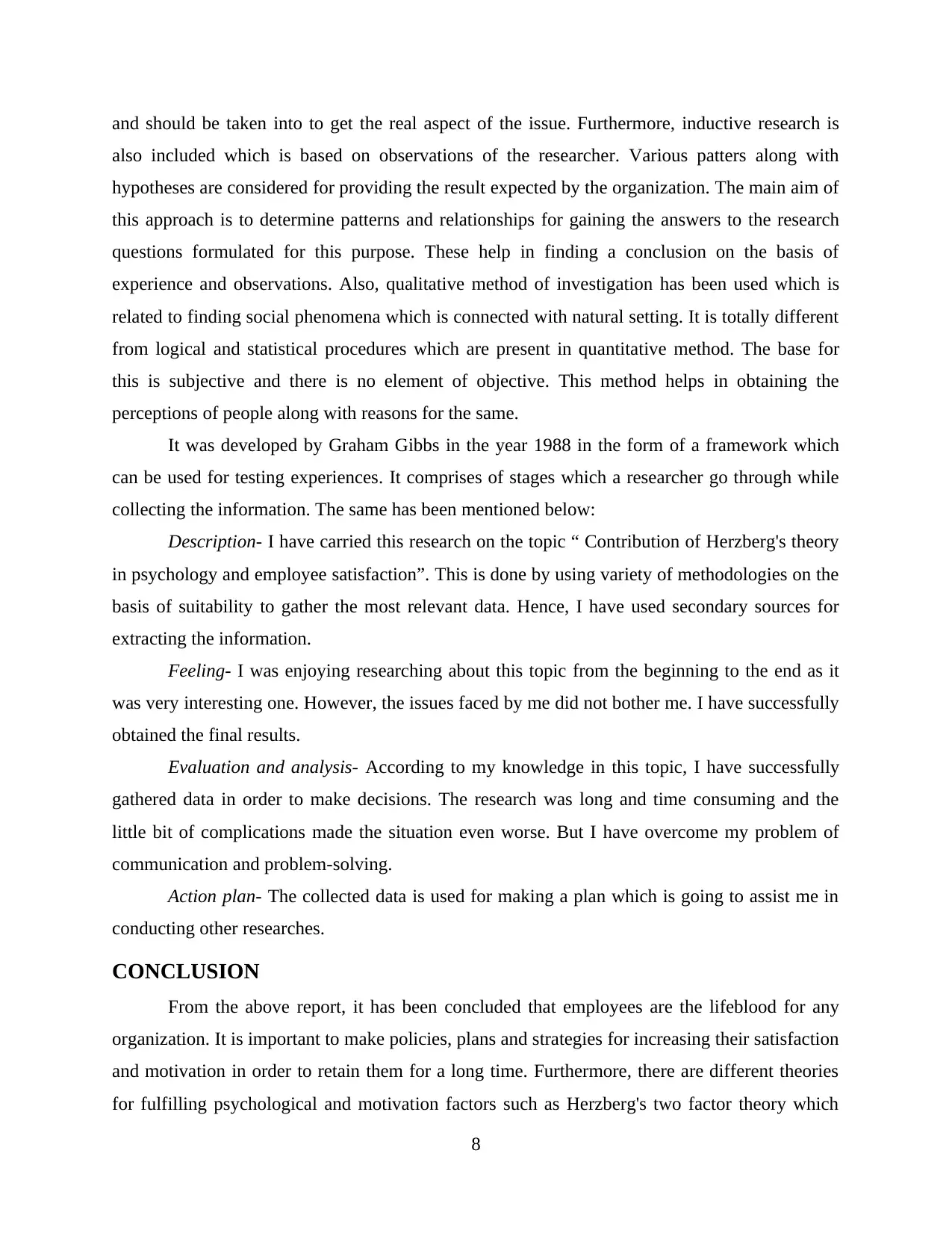
and should be taken into to get the real aspect of the issue. Furthermore, inductive research is
also included which is based on observations of the researcher. Various patters along with
hypotheses are considered for providing the result expected by the organization. The main aim of
this approach is to determine patterns and relationships for gaining the answers to the research
questions formulated for this purpose. These help in finding a conclusion on the basis of
experience and observations. Also, qualitative method of investigation has been used which is
related to finding social phenomena which is connected with natural setting. It is totally different
from logical and statistical procedures which are present in quantitative method. The base for
this is subjective and there is no element of objective. This method helps in obtaining the
perceptions of people along with reasons for the same.
It was developed by Graham Gibbs in the year 1988 in the form of a framework which
can be used for testing experiences. It comprises of stages which a researcher go through while
collecting the information. The same has been mentioned below:
Description- I have carried this research on the topic “ Contribution of Herzberg's theory
in psychology and employee satisfaction”. This is done by using variety of methodologies on the
basis of suitability to gather the most relevant data. Hence, I have used secondary sources for
extracting the information.
Feeling- I was enjoying researching about this topic from the beginning to the end as it
was very interesting one. However, the issues faced by me did not bother me. I have successfully
obtained the final results.
Evaluation and analysis- According to my knowledge in this topic, I have successfully
gathered data in order to make decisions. The research was long and time consuming and the
little bit of complications made the situation even worse. But I have overcome my problem of
communication and problem-solving.
Action plan- The collected data is used for making a plan which is going to assist me in
conducting other researches.
CONCLUSION
From the above report, it has been concluded that employees are the lifeblood for any
organization. It is important to make policies, plans and strategies for increasing their satisfaction
and motivation in order to retain them for a long time. Furthermore, there are different theories
for fulfilling psychological and motivation factors such as Herzberg's two factor theory which
8
also included which is based on observations of the researcher. Various patters along with
hypotheses are considered for providing the result expected by the organization. The main aim of
this approach is to determine patterns and relationships for gaining the answers to the research
questions formulated for this purpose. These help in finding a conclusion on the basis of
experience and observations. Also, qualitative method of investigation has been used which is
related to finding social phenomena which is connected with natural setting. It is totally different
from logical and statistical procedures which are present in quantitative method. The base for
this is subjective and there is no element of objective. This method helps in obtaining the
perceptions of people along with reasons for the same.
It was developed by Graham Gibbs in the year 1988 in the form of a framework which
can be used for testing experiences. It comprises of stages which a researcher go through while
collecting the information. The same has been mentioned below:
Description- I have carried this research on the topic “ Contribution of Herzberg's theory
in psychology and employee satisfaction”. This is done by using variety of methodologies on the
basis of suitability to gather the most relevant data. Hence, I have used secondary sources for
extracting the information.
Feeling- I was enjoying researching about this topic from the beginning to the end as it
was very interesting one. However, the issues faced by me did not bother me. I have successfully
obtained the final results.
Evaluation and analysis- According to my knowledge in this topic, I have successfully
gathered data in order to make decisions. The research was long and time consuming and the
little bit of complications made the situation even worse. But I have overcome my problem of
communication and problem-solving.
Action plan- The collected data is used for making a plan which is going to assist me in
conducting other researches.
CONCLUSION
From the above report, it has been concluded that employees are the lifeblood for any
organization. It is important to make policies, plans and strategies for increasing their satisfaction
and motivation in order to retain them for a long time. Furthermore, there are different theories
for fulfilling psychological and motivation factors such as Herzberg's two factor theory which
8
Paraphrase This Document
Need a fresh take? Get an instant paraphrase of this document with our AI Paraphraser

has been used in this report. The research methodologies along with comparison and contrast
have also been included for understanding the details of different data so collected.
9
have also been included for understanding the details of different data so collected.
9
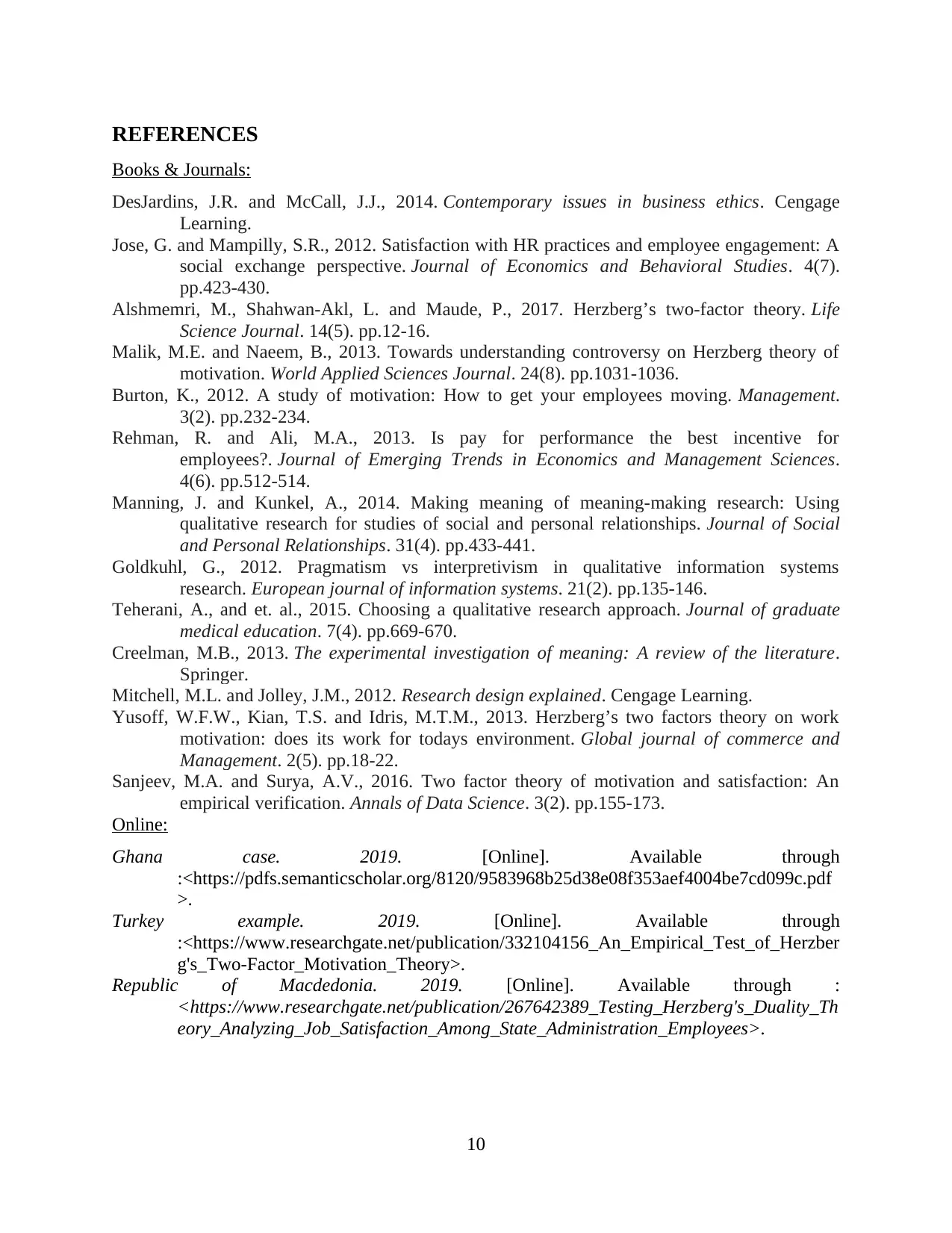
REFERENCES
Books & Journals:
DesJardins, J.R. and McCall, J.J., 2014. Contemporary issues in business ethics. Cengage
Learning.
Jose, G. and Mampilly, S.R., 2012. Satisfaction with HR practices and employee engagement: A
social exchange perspective. Journal of Economics and Behavioral Studies. 4(7).
pp.423-430.
Alshmemri, M., Shahwan-Akl, L. and Maude, P., 2017. Herzberg’s two-factor theory. Life
Science Journal. 14(5). pp.12-16.
Malik, M.E. and Naeem, B., 2013. Towards understanding controversy on Herzberg theory of
motivation. World Applied Sciences Journal. 24(8). pp.1031-1036.
Burton, K., 2012. A study of motivation: How to get your employees moving. Management.
3(2). pp.232-234.
Rehman, R. and Ali, M.A., 2013. Is pay for performance the best incentive for
employees?. Journal of Emerging Trends in Economics and Management Sciences.
4(6). pp.512-514.
Manning, J. and Kunkel, A., 2014. Making meaning of meaning-making research: Using
qualitative research for studies of social and personal relationships. Journal of Social
and Personal Relationships. 31(4). pp.433-441.
Goldkuhl, G., 2012. Pragmatism vs interpretivism in qualitative information systems
research. European journal of information systems. 21(2). pp.135-146.
Teherani, A., and et. al., 2015. Choosing a qualitative research approach. Journal of graduate
medical education. 7(4). pp.669-670.
Creelman, M.B., 2013. The experimental investigation of meaning: A review of the literature.
Springer.
Mitchell, M.L. and Jolley, J.M., 2012. Research design explained. Cengage Learning.
Yusoff, W.F.W., Kian, T.S. and Idris, M.T.M., 2013. Herzberg’s two factors theory on work
motivation: does its work for todays environment. Global journal of commerce and
Management. 2(5). pp.18-22.
Sanjeev, M.A. and Surya, A.V., 2016. Two factor theory of motivation and satisfaction: An
empirical verification. Annals of Data Science. 3(2). pp.155-173.
Online:
Ghana case. 2019. [Online]. Available through
:<https://pdfs.semanticscholar.org/8120/9583968b25d38e08f353aef4004be7cd099c.pdf
>.
Turkey example. 2019. [Online]. Available through
:<https://www.researchgate.net/publication/332104156_An_Empirical_Test_of_Herzber
g's_Two-Factor_Motivation_Theory>.
Republic of Macdedonia. 2019. [Online]. Available through :
<https://www.researchgate.net/publication/267642389_Testing_Herzberg's_Duality_Th
eory_Analyzing_Job_Satisfaction_Among_State_Administration_Employees>.
10
Books & Journals:
DesJardins, J.R. and McCall, J.J., 2014. Contemporary issues in business ethics. Cengage
Learning.
Jose, G. and Mampilly, S.R., 2012. Satisfaction with HR practices and employee engagement: A
social exchange perspective. Journal of Economics and Behavioral Studies. 4(7).
pp.423-430.
Alshmemri, M., Shahwan-Akl, L. and Maude, P., 2017. Herzberg’s two-factor theory. Life
Science Journal. 14(5). pp.12-16.
Malik, M.E. and Naeem, B., 2013. Towards understanding controversy on Herzberg theory of
motivation. World Applied Sciences Journal. 24(8). pp.1031-1036.
Burton, K., 2012. A study of motivation: How to get your employees moving. Management.
3(2). pp.232-234.
Rehman, R. and Ali, M.A., 2013. Is pay for performance the best incentive for
employees?. Journal of Emerging Trends in Economics and Management Sciences.
4(6). pp.512-514.
Manning, J. and Kunkel, A., 2014. Making meaning of meaning-making research: Using
qualitative research for studies of social and personal relationships. Journal of Social
and Personal Relationships. 31(4). pp.433-441.
Goldkuhl, G., 2012. Pragmatism vs interpretivism in qualitative information systems
research. European journal of information systems. 21(2). pp.135-146.
Teherani, A., and et. al., 2015. Choosing a qualitative research approach. Journal of graduate
medical education. 7(4). pp.669-670.
Creelman, M.B., 2013. The experimental investigation of meaning: A review of the literature.
Springer.
Mitchell, M.L. and Jolley, J.M., 2012. Research design explained. Cengage Learning.
Yusoff, W.F.W., Kian, T.S. and Idris, M.T.M., 2013. Herzberg’s two factors theory on work
motivation: does its work for todays environment. Global journal of commerce and
Management. 2(5). pp.18-22.
Sanjeev, M.A. and Surya, A.V., 2016. Two factor theory of motivation and satisfaction: An
empirical verification. Annals of Data Science. 3(2). pp.155-173.
Online:
Ghana case. 2019. [Online]. Available through
:<https://pdfs.semanticscholar.org/8120/9583968b25d38e08f353aef4004be7cd099c.pdf
>.
Turkey example. 2019. [Online]. Available through
:<https://www.researchgate.net/publication/332104156_An_Empirical_Test_of_Herzber
g's_Two-Factor_Motivation_Theory>.
Republic of Macdedonia. 2019. [Online]. Available through :
<https://www.researchgate.net/publication/267642389_Testing_Herzberg's_Duality_Th
eory_Analyzing_Job_Satisfaction_Among_State_Administration_Employees>.
10
⊘ This is a preview!⊘
Do you want full access?
Subscribe today to unlock all pages.

Trusted by 1+ million students worldwide
1 out of 13
Related Documents
Your All-in-One AI-Powered Toolkit for Academic Success.
+13062052269
info@desklib.com
Available 24*7 on WhatsApp / Email
![[object Object]](/_next/static/media/star-bottom.7253800d.svg)
Unlock your academic potential
Copyright © 2020–2025 A2Z Services. All Rights Reserved. Developed and managed by ZUCOL.




